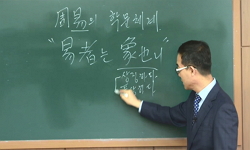도산서당에서 퇴계가 지은 <도산십이곡>은 "언지"와 "언학"으로 구분된다. 하나를 둘로 구분한 것은 『주역』에서 太極이 陽과 陰을 생한다는 원리와 유사하다. 그리고 언지와 언학은 각...
http://chineseinput.net/에서 pinyin(병음)방식으로 중국어를 변환할 수 있습니다.
변환된 중국어를 복사하여 사용하시면 됩니다.
- 中文 을 입력하시려면 zhongwen을 입력하시고 space를누르시면됩니다.
- 北京 을 입력하시려면 beijing을 입력하시고 space를 누르시면 됩니다.

<도산십이곡(陶山十二曲)>의 천명사상(天命思想) 연구 = A study on the philosophy of Heaven's Will shown in Dosansibigok
한글로보기https://www.riss.kr/link?id=A60173462
- 저자
- 발행기관
- 학술지명
- 권호사항
-
발행연도
2009
-
작성언어
-
-
주제어
퇴계 ; 도산서당 ; 도산십이곡 ; 언지 ; 언학 ; 주역 ; 태극 ; 음양 ; 몽괘 ; 과행육덕 ; 천명사상 ; Toegye ; Dosan Seodang ; Dosansibigok ; Eon-Ji ; Eon-Hak ; Zhouyi ; Taiji ; yin and yang ; trigram of Meng ; Gwa-Hang-Yook-Deok ; philosophy of Heaven's will
-
KDC
151.5305
-
등재정보
KCI등재
-
자료형태
학술저널
- 발행기관 URL
-
수록면
163-188(26쪽)
- 제공처
- 소장기관
-
0
상세조회 -
0
다운로드
부가정보
국문 초록 (Abstract)
도산서당에서 퇴계가 지은 <도산십이곡>은 "언지"와 "언학"으로 구분된다. 하나를 둘로 구분한 것은 『주역』에서 太極이 陽과 陰을 생한다는 원리와 유사하다. 그리고 언지와 언학은 각각 육곡의 연시조로 구성된다. 육곡 구성은, 퇴계가 이별의 육가를 모방하였다고 하지만, 『주역』에서 한 괘가 여섯 효로 구성되는 원리와 유사하다.도산서당의 뒤에는 산이 있고 앞에는 물이 흐른다. 도산서당에서 지은 <도산십이곡>의 언지 제5곡과 언학 제5곡에서 산과 물이 겸한 공간이 설정된다. 이런 산과 물의 만남은 산수몽괘를 연상하는 공간이다. 이런 사실은 <도산십이곡>을 산수몽괘와 관련하여 이해할 수 있도록 한다.산수몽괘는 무지몽매를 상징하는 자연의 이치를 통해서 군자가 果行育德해야 함을 제시하며, 산수몽괘의 육효는 發蒙, 包蒙, 勿用取女, 困蒙, 童蒙, 擊蒙의 단계로 변화한다. 산수몽괘의 과행육덕과 육효의 변화하는 내용은 <도산십이곡>의 창작 연원을 밝히고 이 작품에 표현된 작가의 사상을 이해하는 데 활용될 수 있다.
다국어 초록 (Multilingual Abstract)
Yi Hwang, a famous Confucianist in the Chosun Dynasty,established a private academy in Dosan(陶山). He believed that located around hills and streams, Dosan was a proper place to thoroughly submit to Heaven's will(天命).Dosansibigok(陶山十二...
Yi Hwang, a famous Confucianist in the Chosun Dynasty,established a private academy in Dosan(陶山). He believed that located around hills and streams, Dosan was a proper place to thoroughly submit to Heaven's will(天命).Dosansibigok(陶山十二曲), 12 songs of Dosan written by Yi Hwang, is regarded a representative of literary tradition to praise beauty of natural landscape.According to Zhouyi(周易), the Book of Changes, hills and streams fall on divination called a trigram of Meng(蒙卦). It suggests that people should follow Gwa-Hang-Yook-Deok(果行育德) meaning decisive acting and virtue fostering. Yi Hwang could connect the concept of Gwa-Hang-Yook-Deok to a trigram of Mong. Embedded in nature such as hills and streams in Dosansibigok, the philosophy of Heaven's will can be explained through relating to conceptions from Zhouyi.Dosansibigok is composed of Eon-Ji(言志) and Eon-Hak(言學). This written structure is similar to the principle of Taiji(太極) which fosters both yang(陽) and yin(陰). Eon-Ji and Eon-Hak consist of 6 songs, which structure is exactly the same to the principle of a trigram consisting of 6 yao(爻).6 songs in Eon-Ji illustrate that people should make steady progress for Gwa-Hang-Yook-Deok. On the other hand, 6 songs in Eon-Hak represent the necessity of steady learning for Gwa-Hang-Yook-Deok. The content represented in each set of the masterpiece reflects changing meaning of each of the yao in a trigram of Mong. In this regard, the main idea of Donsansibigok results finally in Gwa-Hang-Yook-Deok.In conclusion, the philosophical principles of Zhouyi is reflected in the formal structure while the meaning of the trigram of Mong and bars has influence on the content of Dosansibigok.
동일학술지(권/호) 다른 논문
-
- 퇴계학부산연구원
- 류준필
- 2009
- KCI등재
-
- 퇴계학부산연구원
- 簡亦精
- 2009
- KCI등재
-
해방 후,전후의"도의"담론과 이퇴계 -<도의의 제국>론의 사정(射程)
- 퇴계학부산연구원
- 강해수
- 2009
- KCI등재
-
퇴계학(退溪學)의 국제적(國際的) 연구동향(硏究動向) 고찰(考察)
- 퇴계학부산연구원
- 성해준(Hae Jun Sung)
- 2009
- KCI등재




 KISS
KISS







